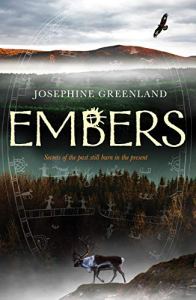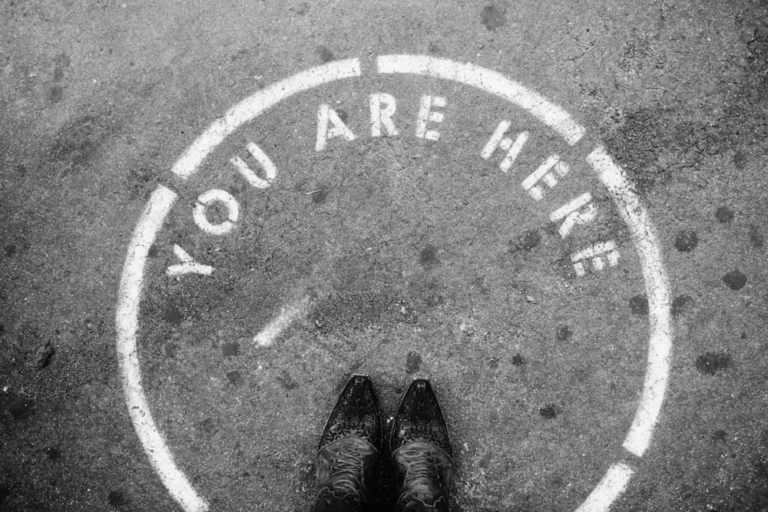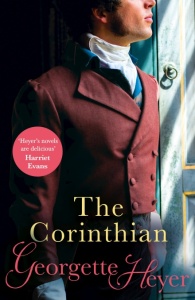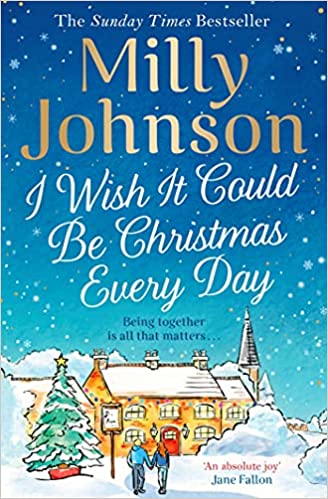Josephine kindly answered a few of my questions.
Embers is a YA Mystery and crime novel set in the fictional mining town of Svartjokk in northern Sweden. It can be described as a Scandi Noir version of The Curious Incident of the Dog in the Night-Time by Mark Haddon. It tells the story of 17-year-old Ellen Blind, who travels to Svartjokk with her brother Simon, a 14-year-old with Asperger’s. They’re on a holiday arranged by their parents, who claim that the siblings should bond, visit the birthplace of their late grandfather, Lars-Erik, and discover their Sami roots. Ellen, though, knows that her parents also want them out of the way so they can sort out their marital problems. The holiday turns upside down when the siblings discover reindeer heads in the forest. Simon’s findings at the scene suggest the reindeer have been poisoned, and he suspects people in the town. Frustrated with the police’s lack of interest, he is determined to solve the case himself. The siblings’ investigation takes them to the local Sami village and the owner of the dead reindeer, Per-Anders Thomasson. It turns out that Per-Anders knows far more about Lars-Erik’s past than the siblings did. The more they learn, the more Ellen suspects that the reindeer killing is somehow connected to their grandfather and the reason he left his home-town and the Sami community behind. As Ellen and Simon are to discover, embers of the past rarely burn out.
I play a lot of music. Mainly violin, but also piano and some singing at times. I find jogging a great way to mull plot lines and characters through my mind and often come up with new ideas while running. I also love hiking, mountains overlooking lakes is my favourite place to be, really!
I do a bit of both! I normally plan out the skeleton of the plot and basic character profiles, and also make a lot of notes on chapters and scenes as I go along, but often find I learn new things about my characters as I write, and figure out the next points of action as I write. The story kind of unfolds itself during the writing process, and it’s very difficult to predict how it will unfold before you start. So yes, once I’ve properly got into a new project, I let the planner in me take a back seat and see where the words take me.
About the Author
2. What inspired the book?
Josephine Greenland is a Swedish-English writer from Eskilstuna, Sweden. She has an MA in Creative Writing from the University of Birmingham and a BA in English from the University of Exeter. Embers is her first novel and was written during her MA course. It is based on her own travels in northern Sweden two years ago with her brother. She is the winner of the 2019 Bumble Bee Flash Fiction Competition by Pulp Literature, the 2017 Fantastic Female Fables Competition by Fantastic Books Publishing, and also the runner-up in the 2018 Summer Solstice Competition by Wild Words. Her fiction and poetry has appeared in Dream Catcher, Literary Yard, Soft Cartel Mag, Plum Tree Tavern, Porridge Magazine, Litro and AHF Magazine. She has also been highly commended in competitions by TSS Publishing and Cinnamon Press. In 2017, she was awarded the Young Writer’s Bursary by Budleigh Salterton Literary Festival. In August 2019, Josephine will begin a PGDE course at the University of Edinburgh to become a Secondary English teacher. When not writing or teaching, she enjoys playing the violin, running and hiking.
Now that’s a great question. I think a question I would like to be asked is: Can writing novels be a form of activism?
Oh that’s a tough question! Probably The Old Man and The Sea, for the profound truths it conveys, and for the language. Hemingway is a master stylist and I’ve always aspired to be able to write like him.
About the Book
Three things. Firstly, the true crime that took place not far from the mining town where my brother and I stayed in northern Sweden during our interrailing holiday the same year. Two teenaged girls discovered a circle of reindeer bodies (decapitated and with their legs chopped off) laid out almost in a ritualistic fashion, in the forest. The culprit was never found. I was shocked and horrified by the gruesomeness of the crime and that anyone in their right mind could commit such an act. This opened my eyes to the hate crime committed against the Sami – the indigenous population of northern Scandinavia and Russia who traditionally made a living out of reindeer herding – and I was compelled to write a book where the culprit was found and put to justice.
Secondly, my own travels with my brother on the Inlandsbana up to Gällivare, the town on which Svartjokk is based. All the activities that Ellen and Simon do before the investigation takes over, the hostel they stayed at the description of the town, are all directly taken from our holiday. Ellen’s and Simon’s relationship is also based on ours, and my brother was the main source of inspiration for Simon’s character.
17-year-old Ellen never wanted a holiday. What is there to do in Svartjokk, a mining town in the northernmost corner of Sweden, with no one but her brother Simon – a boy with Asperger’s and obsessed with detective stories – for company?
6. If you could only read one book for the rest of your life which book would it be?
Nothing, until they stumble upon a horrifying crime scene that brings them into a generations-long conflict between the townspeople and the native Sami. When the police dismiss Simon’s findings, he decides to track down the perpetrator himself. Ellen reluctantly helps, drawn in by a link between the crime and the siblings’ own past. What started off as a tedious holiday soon escalates into a dangerous journey through hatred, lies and self-discovery that makes Ellen question not only the relationship to her parents, but also her own identity.
Two siblings, one crime. One long-buried secret.
4. Is there anything about the process of publishing a book that surprised you?
How drawn out it is! I remember, when I sent in the final version of the manuscript to the editors, I thought the process from editing to published would be about 6 months. It turned out to be three times that length, the pandemic and regulations that came with Brexit not helping. I know now that one needs to have a lot of patience with the publishing industry, and that one spends most of the production time waiting for the next person (editor, copy editor, cover designer etc) to do their bit on the book.
Embers is a chilling and haunting who-dunnit with a Scandi-Noir twist, set against the backdrop of the deep, Swedish forests and the mysticism of Sami folklore.
1. Tell us a little about Embers.
3. Are you a plan, plan, plan writer or do you sit down and see where the words take you?
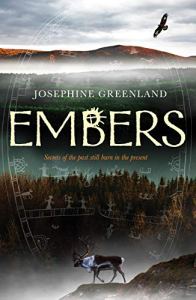
Josephine Greenland is the author of Embers, which was published by Unbound on 18 March 2021.
The third inspiration is Sami folkore. Intrigued by the ritual circle the reindeer bodies had been laid out in in the original crime, I researched ritual sites and came across the concept of a seit – a holy place – and the shaman drum (which is featured on the book’s front cover, etched into the forest landscape). The drum was traditionally used to predict the future, and featured a map of the cosmos, with the sun in its centre. As is uncovered later in the novel, the sun and its role in Sami religion, becomes of key significance. The symbol, a form of cross, is also featured in the title on the book cover, woven into the letter ‘B’.
Answer: Absolutely. At its core, this is ultimately what Embers is. A written protest against the hate crime and violation committed against the Sami and other first nations people around the world. I wrote this book to act as a mouthpiece, as a way to spread the truth about the every day prejudice they suffer through to a wider audience, outside Scandinavia. Before I travelled to Gällivare, I had no idea about these atrocities – indeed, the south of Sweden-Stockholm is pretty ignorant about what goes on in the far north of the country, and up until now, it’s had little representation in the media. I also felt it important to give an outsider’s perspective on these issues, to show that it’s not only the Sami themselves who care and protest, and that everyone, no matter how far away, can raise their voice and have an impact.
5. What do you do when you aren’t writing? What do you do to relax and get away from it all?
7. I like to end my Q&As with the same question so here we go. During all the Q&As and interviews you’ve done what question have you not been asked that you wish had been asked – and what’s the answer?
